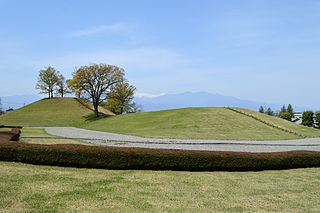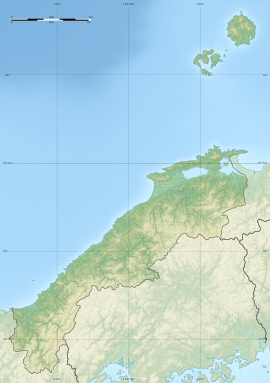
The Yanase Futagozuka Kofun (簗瀬二子塚古墳) is a Kofun period burial mound located in the Yanase neighborhood the city of Annaka, Gunma Prefecture in the northern Kantō region of Japan. It was designated a National Historic Site of Japan in 2012. It is the only keyhole-shaped kofun, found along the Usui River and one of the largest in Gunma Prefecture.

The Hodota Kofun Cluster (保渡田古墳群) is a group of three Kofun period burial mounds located in what is now the city of Takasaki, Gunma Prefecture in the northern Kantō region of Japan. It was designated a National Historic Site of Japan in 1985.

The Shiroishi Inariyama Kofun (白石稲荷山古墳) is a Kofun period burial mound located in the Shiroishi neighborhood of the city of Fujioka, Gunma Prefecture in the northern Kantō region of Japan. It was designated a National Historic Site of Japan in 1993. It is one of several kofun in the Shiroishi Kofun cluster. The National Historic designation was expanded in the year 2009 to cover two nearby kofun: the Junitenzuka Kofun (十二天塚古墳) and the Junitenkitazuka Kofun (十二天塚北古墳).

Sōja Futagoyama Kofun (総社二子山古墳) is a Kofun period burial mound located in what is now the city of Maebashi, Gunma Prefecture in the northern Kantō region of Japan. It was designated a National Historic Site of Japan in 1927. It is also sometimes referred to as the Dantaiyama Kofun (男体山古墳).

The Kai Chōshizuka Kofun (甲斐銚子塚古墳) is a kofun burial mound located in the Shimosone neighborhood of the city of Kōfu, Yamanashi in the Chūbu region of Japan. Together with the adjacent Maruyamazuka Kofun (丸山塚古墳) it was designated as a National Historic Site of Japan in 1930. It is one of the largest keyhole-shaped tumuli in eastern Japan and has a total length of 169 meters. The tumuli are located a three minute walk from the "Kenritsukōkohakubutsukan" bus stop on the Yamanashi Kōtsu Kankō Bus from Kōfu Station.

Mayuyama Kofun (摩湯山古墳) is a Kofun period keyhole-shaped burial mound, located in the Mayu neighborhood of the city of Kishiwada, Osaka in the Kansai region of Japan. The tumulus was designated a National Historic Site of Japan in 1956, with the area under protection expanded in 2010.

The Futagozuka Kofun (二子塚古墳) is a Kofun period keyhole-shaped burial mound, located in the Yamaga neighborhood of the town of Taishi, Minamikawachi District, Osaka in the Kansai region of Japan. The tumulus was designated a National Historic Site of Japan in 1956, with the area under protection extended in 2019. It is the one of the Isonagadani Kofun Cluster (磯長谷古墳群), a group of 30 kofun, five of which have been designated as imperial tombs by the Imperial Household Agency.

The Danjōzuka Kofun (壇場山古墳) refers to a group of kofun burial mounds located in the Mikuninochō-Kokubunji neighborhood of the city of Himeji, Hyōgo Prefecture, in the Kansai region of Japan. Four tumuli were collectively designated a National Historic Site in 1921.

The Goshikizuka Kofun (五色塚古墳) is a kofun burial mound located in the Goshikiyama neighborhood of Tarumi-ku, Kobe, Hyōgo Prefecture, in the Kansai region of Japan. The tumulus is the largest in Hyōgo Prefecture, and is estimated to have been built around the end of the 4th century and the beginning of the 5th century. It is known as the first kofun to be restored to what archaeologists believe to be its original appearance. It is also known as the Sentsubo Kofun (千壺古墳). Together with the smaller neighboring Kotsubo Kofun (小壺古墳) it was designated a National Historic Site in 1921, with the area under protection extended in 1974, 1979 and 2006.

Futagozuka Kofun (二子塚古墳) is a Kofun period keyhole-shaped burial mound, located in the Nakashima Ekiyacho neighborhood of the city of Fukuyama, Hiroshima in the San'yō region of Japan. The tumulus was designated a National Historic Site of Japan in 2009. It is noted for the large quantity of grave goods discovered.
Jinbayama Kofun (仁馬山古墳) is a Kofun period keyhole-shaped burial mound, located in the Nobuyuki neighborhood of the city of Shimonoseki, Yamaguchi in the San'yō region of Japan. The tumulus was designated a National Historic Site of Japan in 1991. It is the largest burial mound in the Nagato region and the third largest in Yamaguchi Prefecture, and is estimated to have been built in the latter half of the 4th century.

The Sukumozuka Kofun (スクモ塚古墳) is a Kofun period keyhole-shaped burial mound, located in the Kugi neighborhood of the city of Masuda, Shimane in the San'in region of Japan. The tumulus was designated a National Historic Site of Japan in 1941. It is the largest in the Iwami region and the largest in Shimane prefecture.
The Takarazuka Kofun (宝塚古墳) is a Kofun period burial mound, located in the Shimogoshi-cho neighborhood of the city of Izumo, Shimane in the San'in region of Japan. The tumulus was designated a National Historic Site of Japan in 1931. It is believed to have been built in the middle of the 6th century, or towards the end of the Kofun period. It is also called the Ippo-zuka (一保塚).

Ishiya Kofun (石屋古墳) is a Kofun period burial mound, located on the border of the Yata-chō and Higashitsuda-chō neighborhoods of the city of Matsue, Shimane in the San'in region of Japan. The tumulus was designated a National Historic Site of Japan in 1979. It is one of the largest rectangular tombs in the San'in region and is in good preservation.

The Kamienyajizōyama Kofun (上塩冶地蔵山古墳) is a Kofun period burial mound, located in the Kamienya-chō, neighborhood of the city of Izumo, Shimane in the San'in region of Japan. The tumulus was designated a National Historic Site of Japan in 1924. It is ne of the burial mounds that make up the Tsukiyama Kofun Cluster.

The Kamienyatsukiyama Kofun (上塩冶築山古墳) is a Kofun period burial mound, located in the Kamienya-cho, neighborhood of the city of Izumo, Shimane in the San'in region of Japan. The tumulus was designated a National Historic Site of Japan in 1924, with the area under protection expanded in 2020. It is one of the burial mounds that make up the Tsukiyama Kofun Cluster. The artifacts excavated from this site were collectively designated a National National Important Cultural Property in 2018.

The Okadayama Kofun (岡田山古墳) is a cluster of seven large and small Kofun period burial mounds, located in the Okusa-cho neighborhood of the city of Matsue, Shimane in the San'in region of Japan. The two larger burial mounds were collectively designated a National Historic Site of Japan in 1965. The artifacts from this site have been collectively designated a National Important Cultural Property in 1985.

The Ageshima Kofun (上島古墳) is a Kofun period keyhole-shaped burial mound, located in the Kunitomi-chō neighborhood of the city of Izumo, Shimane in the San'in region of Japan. The tumulus was designated a National Historic Site of Japan in 1957. It is believed to have been built in the middle of the 6th century, or towards the end of the Kofun period.
The Yamashiro Hōfun (山代方墳) is a Kofun period burial mound, located in the Yamashiro-cho neighborhood of the city of Matsue, Shimane in the San'in region of Japan. The tumulus was designated a National Historic Site of Japan in 1941. It is one of the largest burial mounds in Shimane Prefecture, and one of the last major burial mounds to have been constructed in the Izumo region.
The Ōbaniwatorizuka (大庭鶏塚古墳) is a Kofun period burial mound, located on the border of the Ōba-chō neighborhood of the city of Matsue, Shimane in the San'in region of Japan. The tumulus was designated a National Historic Site of Japan in 1924.



















